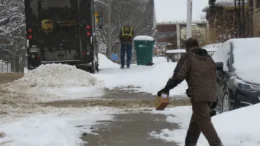Roses (Rosa spp.) have been one of the most beloved flowers throughout history. Their colors even have meaning: red for love, yellow for friendship, white for innocence and new love, etc. Roses can be incredibly tough and long-lived plants in the garden. Old garden roses grace almost-forgotten cemeteries throughout rural America. The oldest living rose is believed to be a climbing wild dog rose (Rosa canina), covering the walls of the apse of Hildesheim Cathedral in Germany. The roots of this 700-year-old plant even survived the building’s destruction by Allied bombs in World War II, growing and blooming each year since 1945.
Fossil evidence of roses dates back 30 million years. Ancient Romans loved roses and would scatter the petals throughout their homes. The Chinese started cultivating roses more than 2500 years ago. Today, there are tens of thousands of cultivars, including many descending from wild Chinese species. Roses are categorized in many ways. There are miniatures, hybrid teas, climbing roses, shrub roses, groundcover roses, rose standards (tree roses), rugosas, polyanthus, grandifloras, floribundas, centifolias, ramblers, albas, as well as China, Damask, English, Gallica, Bourbon, etc. Understanding the breadth of the types of roses can be overwhelming. When selecting a rose for your garden, you can choose characteristics of color, height, width, fragrance, disease resistance, bloom time, bloom size, type of bloom, frequency of bloom, cold-hardiness, whether the rose is container- or shade-friendly, and whether the rose is grafted onto a different rootstock or growing from its own roots. There is a rose for almost every garden.
Among the most critical steps for a gardener to take to give their roses the best chance for a long and healthy life is to provide protection for them during our harsh Pennsylvania winters. Before discussing specific actions to take, it is vital to discuss three main factors that influence the potential for a rose to survive the winter and thrive next season.
The Health of the Rose
Keep your rose healthy throughout the growing season. Healthier roses have a better chance of surviving winter challenges. Prune the rose for health: remove dead or diseased canes and allow for airflow into the plant. This will reduce the incidence of fungal diseases such as black spot, powdery mildew, and rust. The type of rose (e.g., climbing vs. shrub) also dictates the desired structure that results from your pruning cuts. Start monthly fertilization in April and stop in August to reduce new growth that may not harden off before winter. Applying a high potassium fertilizer in the fall may increase winter hardiness once the plant is dormant. Stop trimming off rose flowers in early fall to allow the hips (seedpods) to develop. This encourages the plant to go into dormancy.
Water as needed throughout the season, and be sure to water thoroughly late in the season, after the first frost but before the ground freezes. The plant needs to go into winter well-hydrated. As with most plants, water the ground and not the foliage. It is also very important to clean up all debris (leaves, fallen flowers, etc.) before the winter so that fungal spores do not overwinter underneath the plant.
Dispose of and do not compost diseased leaves and plant parts. Due to the spread of rose rosette disease, dig up and bag any nearby multiflora roses.
Location and Exposure of the Rose
Pennsylvania’s climate varies from USDA Hardiness Zones 5a through 7b. This zone is based on the average annual winter minimum temperatures. You should know your garden’s hardiness zone. However, exposure to the wind is also an important factor, as is being aware that severe winter storms and polar vortices seem to be ever more frequent due to climate change. A climbing rose growing against a house in a protected area can withstand desiccating winter winds better than a rose climbing on a trellis or obelisk in the middle of an exposed garden. Container-grown roses must be protected in the winter—their roots are above ground and will be particularly exposed to the cold.
The Type and Hardiness of the Rose
As with all plants, each species or cultivar of rose will have a defined hardiness zone that should be provided by the grower. A rose cultivar that has been specially bred to be hardy in Zone 4 will need little to no added protection when growing in a Zone 7b garden. Some roses have a graft union (also called the bud union) that is very vulnerable to cold and, therefore, needs protection during the winter. If the graft union is compromised, the part of the plant above that graft union will die. For many hybrid tea roses, the graft union is near the ground.
However, the graft union for rose standards may be more than three feet above the ground, which complicates the provision of winter protection. Own-root roses, which are grown from cuttings taken from stock plants and not grafted onto a different rootstalk, may also need protection, depending on their hardiness compared with the garden’s hardiness zone. If the canes of an own-root rose die back, new ones will often emerge from the rose’s deep roots. My own-root, climbing, ‘Cecile Brunner’ rose, is growing in an exposed site in my USDA Hardiness Zone 6b garden. In its 20+ years in that location, it has died back to the ground twice due to Zone 4 polar vortex wind chills. Both times, canes have emerged in the spring, and they continue to bloom gloriously.
How to Protect Your Roses
With all roses, clean up all debris and proceed with winter insulation only after several killing freezes to ensure that winter dormancy has been reached. The idea is to keep the rose and surrounding soil consistently cold and protect it from both winter warm and cold spells and the resulting freeze-thaw cycle.
Own-Root Roses
The hardier the rose, the less harm it may sustain in winter and thus less preparation is needed. For maximum protection in colder areas, create a 12-inch-deep mound of well-draining compost, potting mix, clean soil, or aged manure around and over the plant. The canes may be loosely tied together prior to mounding to prevent movement in strong winds. Once frozen, cover this with a few inches of tree leaves, tree boughs, or ground bark mulch for further insulation and to keep what’s below it in place.
Container Roses
Moving the entire container into an unheated garage or shed is the easiest option. If that is not an option, place the container in as protected of an area outside as possible. Then, provide insulation surrounding the container and the rose. The entire container and several inches above the rim can be wrapped with multiple layers of big-bubble bubble wrap. Mound compost and tree leaves on top of the base of the rose plant, as described above. Alternatively, create a fence around the entire container using wire fencing or hardware cloth. Then, place tree leaves or straw in the fence until the entire container is covered. Mound the base of the rose as described above. Alternatively, the container can be put in a large box and filled with straw or leaves. Another option for roses in smaller pots is to bury the pot in the ground. This should be done once the plant is dormant and before the ground freezes. You may then create a mound over and around the plant as mentioned above.
Grafted Roses
The bud union on grafted roses must be protected during the winter. Where the graft is near the ground, mound well-draining compost, potting mix, clean soil, or aged manure on the plant’s crown so that the graft union is covered by about a foot. Cover this with a few inches of tree leaves, tree boughs, or ground bark mulch for further insulation and to keep what’s below it in place.
Rose Standards (Tree Roses)
Rose standards have their bud union several feet above the ground, atop a tall stem. The stem, bud union, and several inches of the canes emerging from the graft will need to be protected. The first method protects the graft area and the stem separately. Cut back the canes to several inches. Wrap the rose’s entire reduced “head” in several layers of bubble wrap. As with container rose protection, create a fence around the stem and fill it with tree leaves or straw. This “fence” can also be made by installing 3 or 4 strong stakes to surround the rose, which is then wrapped with burlap. The second method (my personal preference) is to lay the entire standard rose down on the ground and cover all of it. This method may be problematic if the rose is among other shrubs and perennials, as in a mixed border. First, loosen half of the rose’s rootball with a garden spading fork to raise that half of the rootball and lay the rose on the ground, securing the canes with stakes or landscape staples. Cover with tree leaves or straw for up to 18 inches above the plant, and then place wire fencing, hardware cloth, or burlap on top of the mound to keep it in place. Secure from winter winds with stones or bricks, as needed.
Climbing Roses
The more exposed the site and the greater the difference between your rose’s hardiness zone and your garden’s hardiness zone, the more steps you will need to take to safeguard the canes of your climbing rose. In my Zone 6b garden, I have a climbing, thornless ‘Zephrine Drouhin’ rose that is in a very protected site. I have provided essentially no extra winter protection other than a few inches of aged manure on its crown for the last 15 years. It has come through even the harshest winters with barely any damage. If you live in a colder zone or your rose is more exposed to wind, you may choose to protect the canes. This involves trimming the canes, tying them together (as needed), and covering them in place with straw wrapped in burlap. Alternatively, remove the canes from the structure on which they are growing and cover them with insulating materials as you would rose standards.
In the Spring
When the weather begins to warm in very early spring and winter lows are not forecasted to dip below 20°F, remove whatever structure you have created and gently start removing the mound from the base of the rose. This may take several attempts as lower layers may still be frozen and need to thaw before removal. If you have buried a tree rose, place it back upright, gently press the roots back into place, and mulch the base of the rose. Some experts recommend gently washing off the newly exposed canes to reduce the incidence of damage from insects and diseases in the covering materials. The rose standard may need to be staked for support. Don’t prune roses too early, as late winter dieback can occur. Start fertilizing again in April.
Roses are a beautiful addition to any garden, whether used in a mixed border or as a focal point. To protect them through the winter, the gardener must consider the plant’s needs and know how the rose’s location can compromise its ability to survive the harshness of winter cold, winds, and the freeze/thaw cycle. Taking precautions in late fall will keep your rose thriving and provide abundant beautiful flowers for seasons to come.
This educational blog is a series of informative articles from the Penn State Master Gardeners volunteers plus news concerning the group and their activities. For more information, click here.






























